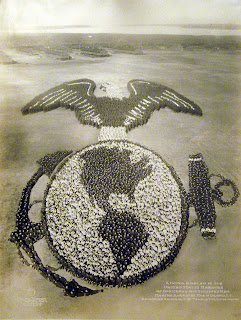
(click photo to view large)
Back before pixels formed images there existed photographers who marshalled the assembled mass of military bodies, religious groups and others into human pixel-like formations as incredible as any in the history of photography. The studio of Mole & Thomas concocted photos with names such as The Living Uncle Sam, The Human American Eagle, or The Human Statue of Liberty that were the combined efforts of the photographers and the thousands of men in uniform that were required to render these images. It is emblematic of a big vision, skillful execution and human patience seldom known today.
The
Carl Hammer Gallery in Chicago has several Mole & Thomas images in their inventory.
This website gives you an idea of the distortion required to achieve a believable effect with 10,000 to 30,000 people.
According to
Cabinet Magazine Arthur Mole's family came to the United States from England to follow the religious teachings of Dr. John Alexander Dowie a Christian utopian who had established a large church as well as the city of Zion, Illinois. The church's choir director John Thomas was enlisted to help Mole with some of his early formations using the church choir. The pair then teamed up to produce succeeding images.
Mole and Thomas began by tracing the image they wanted to produce on the ground glass of an 11x14 view camera. According to
Cabinet Magazine "Using a megaphone, body language, and a long pole with a white flag tied to the end to point to the more remote areas where the bulk of the troops had to be stationed, Mole would then position his helpers on the field as they nailed the pattern to the ground with miles of lace edging. In this way, Mole also figured out the exact number of troops required." The photos often took a week or more to complete.
